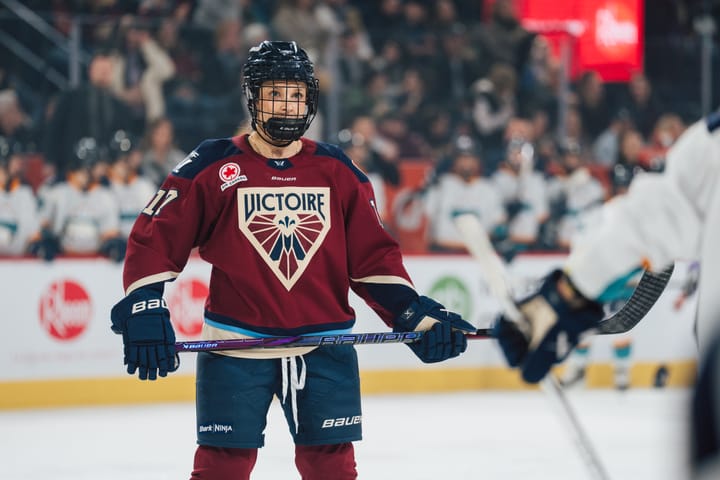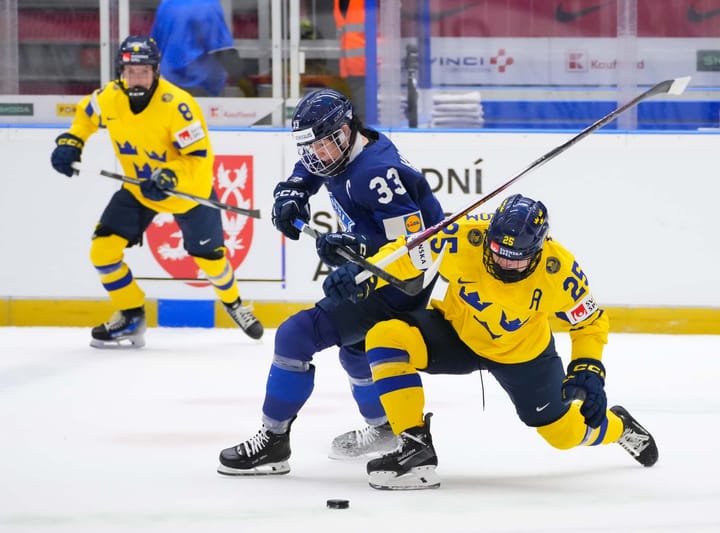CWHL announces new expansion team in China
The CWHL will have a sixth team next season, Kunlun Red Star, that will be based in Shenzhen.
Canadian women’s hockey has come a long way from Sami Jo Small’s home office to the Great Hall inside the Hockey Hall of Fame.
The CWHL announced at a press conference Monday that the league is expanding to China and that Kunlun Red Star has become the sixth franchise that will compete for the Clarkson Cup, which was displayed prominently at the podium.
News of this announcement was first reported by The Ice Garden, followed by the scoop through Finnish media that Olympians Kelli Stack and Noora Räty had signed on with the Chinese club. Both were in attendance Monday alongside commissioner Brenda Andress, former player Tessa Bonhomme, Les Canadiennes de Montréal star Julie Chu, and Phil Esposito (who is part of the KRS advisory board), as well as members of the KRS organization.
KRS will play out of China next season, meaning the five current CWHL teams will each make separate trips across the globe to compete in regular season play, while KRS will travel to North America several times to visit each of the other five teams.
“It’s a historic moment for the Canadian Women’s Hockey League and for women’s hockey around the world,” said Andress. “This expansion goes along with the CWHL mission to grow the game and create opportunities across the world for women. [It’s important] to support women, not only on the ice but off the ice to continue to grow our national programs.”
While KRS contributed an unnamed fee to join the league, there was not any announcement on whether any of the players on the six teams would be paid a salary next season. Currently, CWHL players are compensated in a number of ways that include travel, meal per diems, and with some team-provided equipment, among other performance-based incentives.
“So I just won my bet,” said Andress, who had anticipated that the first question at the press conference would ask whether or not league policy had changed and players would be paid. “KRS will follow the same policies and procedures [as do the existing CWHL clubs].”
Andress cited “partnerships” and “sponsorships” that will help finance the added travel costs and expansion, and added that there is no set fee that would guarantee a club joining the CWHL, only an appropriate fit that is in the best interests of the league.
The fit between KRS and the CWHL seems to be about mutual benefit. China gets to place a team in an elite level league while the CWHL gets a potentially massive audience in east Asia. A reported 120 million people in China watched the Sochi 2014 men’s gold medal final, and six million watched Game 4 of the 2016 Stanley Cup Final. While this means that there were more people watching in China than in the US, it’s still only a fraction of the possible Chinese audience. [source].
“China’s a powerhouse and the CWHL wants to be part of that,” said Andress. “We were lucky enough to get in [before other pro leagues] and set the blueprint.”
The commissioner added that there will be a “massive expansion” of the number of games that will be broadcasted live next season, whereas at most a quarter of them were made available for viewing in 2016-17. The NHL, meanwhile, will play pre-season games in China next season.
Zhao notes that initial conversations between KRS and the CWHL began about eight months ago.
“This is a marriage across the Pacific,” he said. “We are hoping, and confident, that one day the Chinese women’s hockey team will make it to the top of the world.”
Räty’s and Stack’s involvement with the KRS club remains somewhat unclear. Both put on the Red Star jersey and posed for photos but Andress indicated that the two remain “free agents” and are not officially team members. All new players to the CWHL must go through the draft process but since no player is paid a salary, they choose the teams by which they would accept being selected.
Stack made it clear that she would not only help train and advise the Chinese national program but would also be wearing the KRS sweater on the ice in 2017-18. The likeliest outcome is that Räty and Stack will indicate that they wish to play in China and will thus be drafted to KRS. Only then can they sign as club members.
Stack, formerly of the United States’ NWHL, said she was contacted about joining KRS a couple of weeks ago after she was left off of Team USA’s centralization roster.
“The NWHL was great in the first year, there was a lot of excitement behind it,” she said. “It’s hard, that second year, to come back at that same level. I wanted to do something new and different and this opportunity is once in a lifetime. I saw it as one I would regret passing on, looking back.”
In fact, any player drafted or currently in the league could indicate that they wish to play in China, making them eligible to be drafted or traded there. The CWHL already has international players in addition to North Americans.
While the long term goal for the CWHL is to grow women’s hockey around the globe, the KRS organization also seeks to improve its national standing ahead of the 2022 Winter Olympics in Beijing. By hosting a CWHL team and bringing players like Stack and Räty, along with board members that include Mike Keenan, Phil Esposito, Bobby Carpenter, Igor Kravchuk, Digit Murphy and more, KRS hopes to field competitive hockey teams on both the men’s and women’s sides.
“In the old days, it [was like] a national team: closed-door training,” said Zhao. “Now we are run like a club so we can join international leagues with imports.”
Beyond the success of the CWHL and of ice hockey in China, a theme put forth by league reps and players on this night was that the act of supporting and playing in women’s hockey is important in a wider, political sense. The U.S. women’s national team, for instance, fought USA Hockey earlier this year, lobbying for more equal treatment and compensation given the benefits USA Hockey gives male players. The women’s team won - both the battle for equal treatment and the subsequent world championships.
“Sports has a voice that’s not often heard except to talk directly about sports,” said Andress. “But the CWHL has always had a mandate to not only talk about our world [in terms of] sports but what’s happening in our world to women. I believe that hockey has to use its voice to continue to recognize that women have a voice, and that the men who support also [use theirs].”
For Les Canadiennes player Chu, who is Chinese-American, the intersection between sport and opportunity is clear.
“I think it’s amazing for young, Chinese girls and young, female hockey players to know that there are no boundaries to what hockey can provide for all of us.”
“To be able to incorporate the KRS team and my Chinese heritage in this league makes it extra special for me, personally. As elite athletes, every time we step onto the ice, we have an opportunity to represent our country or team. That’s our opportunity to make a difference for young athletes who aspire to get to the next level, for young girls who’ve never thought about playing hockey. I’m living a dream every day.”





Comments ()